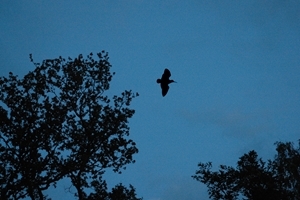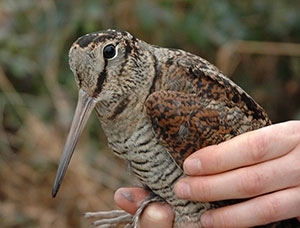 Residents and migrants
Residents and migrants
Britain and Ireland support a relatively small resident breeding population of woodcock. Counts of displaying males give us the best information on trends in our breeding woodcock and the current British population estimate is 55,240 males. The European breeding population is estimated at 6-8 million males. In winter we see a large influx of migrant woodcock from the main European breeding grounds in Norway, Sweden, Finland, the Baltic States and Russia. Migrants typically arrive in all months from October to January, but the timing and numbers vary regionally within Britain and Ireland, as well as annually according to the severity of cold weather on the continent. It is estimated that between 800,000 and 1.3 million migrant woodcock winter here, with most departing in March.
The decline in our resident population

Research by the GWCT and British Trust for Ornithology (BTO) shows a severe decline in the population size and breeding range of our resident woodcock since 1970. BTO Atlas data indicate that woodcock presence fell by 56% at the 10km square scale between 1970 and 2010. In randomised surveys across Britain in 2003 and 2013, funded by the GWCT, occupancy of 1km squares that contained at least 10ha of woodland dropped from 35% to 22%. The British population estimate fell by 29% from 78,350 males in 2003 to 55,240 males in 2013. Both data sources suggest regional variation in the rate of decline, with losses greatest in the west and south. Given the scale of the decline, the woodcock was moved from amber to red status on the UK’s Birds of Conservation Concern in December 2015.
We do not fully understand what is driving the decline in our breeding woodcock, but we expect there to be multiple factors involved. Principally, changing climate and changes in the suitability and management of woodland are likely to be important. Analysing data from the Breeding Woodcock Survey, alongside complementary habitat data, we have shown that woodcock populations have retracted to blocks of larger, well-connected woodland that offer a diverse mosaic of woodland habitats. Woodcock favour stands of young dense trees with patchy ground cover when brood-rearing and rely on open areas for display and nocturnal feeding. It is likely that a lack of woodland management in many small or medium-sized woods means that they no longer offer the structural diversity that woodcock require.
Other ground-nesting wading birds in open habitats, such as the curlew and lapwing, are declining as a result of predation on eggs and chicks and high nest predation rates have recently been documented in some declining woodland songbirds. Increased recreational activity in spring and summer by people in woodland may be an issue because the woodcock is particularly susceptible to disturbance when nesting.
At present, we cannot rule out shooting as a factor contributing to the decline of our resident woodcock. We have commenced work to examine the effect of shooting on breeding woodcock numbers and produce guidance on sustainable harvest rates, but this is not yet complete.
Woodcock monitoring in the main European breeding areas indicates that the European population is stable and there is no evidence for a change in the numbers of migrant woodcock wintering in Britain and Ireland.
Reducing the impact of shooting on residents
We do not believe that a ban on woodcock shooting would help recover our resident woodcock, in the long term, for three reasons. First, there is an indication, at a national scale, of a reduction in hunting pressure over the last 20 years, with many people deciding voluntarily that they no longer wish to shoot woodcock. Second, a ban might remove the motivation for many landowners to manage their woods in ways that will maintain suitable habitat for woodcock. Third, parts of western Britain have no history of breeding woodcock, but host large numbers of migrants, so shooting in these areas does not put residents at risk except during cold spells when residents might move south and west1.
However, until we better understand the reasons for the decline in our breeding woodcock and the effects of shooting, we believe it would be prudent for those that intend to shoot woodcock to:
1. AVOID SHOOTING WOODCOCK EARLY IN THE SEASON
Although migrant woodcock begin to arrive in October and November, at most sites across the UK numbers continue to build throughout the autumn/winter and do not peak until December. Delaying shooting until the majority of these migrants, that originate from stable continental populations, have arrived reduces the risk of any possible impact to vulnerable resident populations. For those that shoot woodcock, beginning shooting after the 1st December provides a useful rule of thumb.
2. IMPROVE THEIR UNDERSTANDING OF THEIR LOCAL WOODCOCK POPULATIONS BEFORE SHOOTING
We advocate improving local knowledge about both the presence of resident breeders and the numbers of woodcock typically present at different times during the winter. Roding counts can be used to detect breeding woodcock where they occur, and over several years provide an indication of local population trends. In autumn/ winter, a gradual increase in the frequency of woodcock sightings helps track the arrival of migrants and indicates the safest time to begin shooting (see above). This might be judged by counts of flighting woodcock at dusk, flush counts during autumn pheasant drives or seen at night during predator control activities. At most sites, migrants will vastly outnumber residents, providing a noticeable change in abundance once migrants have arrived. Information on how to count residents in summer can be found here.
3. SHOW RESTRAINT EVEN WHERE RESIDENT BIRDS ARE ABSENT
Restraint when shooting woodcock makes sense even in areas where there are no local breeders, because we know from our satellite tracking and annual ringing of woodcock that the majority of migrant woodcock are extremely faithful to the same wintering site year on year. Overshooting will therefore break the migratory link with your shoot and is likely to lead to fewer woodcock being seen in future.
4. SHOOT FLIGHT LINES WITH CAUTION
Shooting woodcock flighting from woodland at dusk carries a higher risk of overshooting. We advise gauging woodcock numbers across known flight lines first and then deciding on a bag, preferably only targeting half the flight lines once per season.
5. CURB SHOOTING IN FREEZING WEATHER
We have conducted research to understand the effect of cold weather on woodcock. Every effort should be made to reduce additional mortality when woodcock are at higher risk of starvation and predation during freezing spells. We are aware that most shoots stop shooting woodcock before a statutory cold weather suspension comes into force after 13 days. Our current advice is that shooters should stop shooting woodcock after four days of frozen conditions and allow the birds at least seven days to recover after the end of the cold period before shooting recommences.
Footnotes
1 Woodcock have historically never bred regularly in Cornwall, Pembrokeshire or the Outer Hebrides and hence, in mild weather, shooting should only affect migrants. Devon, Somerset, Carmarthenshire, Ceredigion and Anglesey have supported only very low and localised numbers of breeding woodcock in the last 50 years and the risk of shooting to residents in these counties is currently low. Very few woodcock currently breed in Galway and Mayo, but the species bred far more widely in these counties until 20-30 years ago.
Download your FREE Woodcock guide from the GWCT team
Simply enter your email address below to download your essential free guide which covers:
✓ Woodcock population trends
✓ Decline in resident woodcock numbers
✓ Our changing woodlands
✓ Woodcock and shooting
✓ GWCT woodcock research and advice